| Author | Message | ||
| Tim Brandt (Timb)
Registered Member Username: Timb Post Number: 381 Registered: 10-2003 Posted From: 74.244.14.221 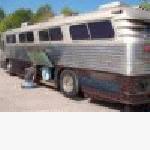 Rating: N/A |
Well fellow busnuts I have been contemplating options and need a sanity check. On my Flxliner there is only 8 inches of clearance between the rear brake mounting flange and the frame members so no room for piggyback brake cans. I am not comfortable the the ICC valve being my only ER brake and would like another option to chocks when parked. The linkage to the driveline brake on the diff is seized and rather than put a lot of effort into repairing it I was considering installing a spring brake on the driveline drum or even converting to an air operated disk brake. Another option that bounced through my mind was installing spring cans in the front which would be fine for parking but I can see control issues in an emergency. Anybody come up with other options in this situation???? Do they make mini spring brake cans for tight spaces??? | ||
| john w. roan (Chessie4905)
Registered Member Username: Chessie4905 Post Number: 1561 Registered: 10-2003 Posted From: 24.74.18.236 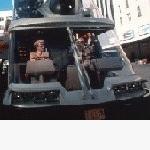 Rating: N/A |
dd3's are short if you can't find a short maxi. The other problem is that you need clearance to install the release bolt in an emergengy to release/cage the emergency spring. If nothing will work, one could section the baggage compartment enough to provide clearance. No maxi's on the front; they are probably illegal in some states. | ||
| Tim Brandt (Timb)
Registered Member Username: Timb Post Number: 382 Registered: 10-2003 Posted From: 74.244.14.221  Rating: N/A |
Hi John, Clearance isn't a problem with the bays but the steel cage that comprises the suspension mounting points. Here is a pic from when I was having my tires mounted http://members.tccoa.com/timb/rear%20brake.jpg | ||
| larry currier (Larryc)
Registered Member Username: Larryc Post Number: 253 Registered: 2-2007 Posted From: 64.12.116.203 Rating: N/A |
Tim, You may be able to pull the brake spiders and put them on the opposite side. Some truck housings work either way. That would put them on the other side of the housing and it looks like you have clearance there. | ||
| Tim Brandt (Timb)
Registered Member Username: Timb Post Number: 383 Registered: 10-2003 Posted From: 74.244.14.221  Rating: N/A |
Thanks Larry. So then I would just need to get someone to weld a mounting bracket on the other side of the axle right? | ||
| David Guglielmetti (Daveg)
Registered Member Username: Daveg Post Number: 81 Registered: 2-2009 Posted From: 66.122.182.185  Rating: N/A |
Brake spiders are available in different 'angles', so find a spider that positions the brake chamber more parallel with the ground. Spiders are usually bolted on. | ||
| FAST FRED (Fast_fred)
Registered Member Username: Fast_fred Post Number: 882 Registered: 10-2006 Posted From: 76.195.78.219 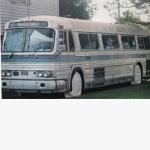 Rating: N/A |
"The linkage to the driveline brake on the diff is seized and rather than put a lot of effort into repairing it,,, " If it is intact , you might be amazed what a few weeks of douching with PB Blaster , or your favorite goo. The ICC setup and actual mechanical break does work well, it stops the bus with full line pressure to the rear wheels ,usually from a protected tank. No chocks are required with the mechanical brake , it is a GREAT safty feature as it can be used in quick stops (fuel, food , place to see)with far less effort than chocking. No extra part$ to purchase , install, maintain , no air lines to run and EZ to operate. FF | ||
| Len Silva (Lsilva)
Registered Member Username: Lsilva Post Number: 271 Registered: 12-2000 Posted From: 24.164.20.23  Rating: N/A |
It looks like you might have enough room to position the cans vertically. | ||
| larry currier (Larryc)
Registered Member Username: Larryc Post Number: 254 Registered: 2-2007 Posted From: 205.188.116.203 Rating: N/A |
The spider is usually just bolt on axle hardware. They position the air cans. Sometimes they are clockable. You can unbolt them and move them to a different position by just rebolting them. Sometimes you could take them and move them from one side to the other and rebolt them moving the air cans 180 degrees. This would simply move the brake cans from the front of the axle to the back. Might be worth a try. | ||
| Tim Brandt (Timb)
Registered Member Username: Timb Post Number: 384 Registered: 10-2003 Posted From: 66.165.176.62  Rating: N/A |
Thanks Larry. I need to take a closer look. I had assumed the brackt for the can was welded to the axle but if it's bolted as part of the spider that really would simplify things. I'll report back | ||
| Tim Brandt (Timb)
Registered Member Username: Timb Post Number: 385 Registered: 10-2003 Posted From: 66.165.176.62  Rating: N/A |
Well I guess you learn something new everyday. Pulled out DaBook and indeed it appears that I might be able to reclock it.....with any luck I can do all that from the backside without disasembling the drum and axle. See attached pic http://members.tccoa.com/timb/Spider.jpg Thanks for schooling me on how these assemblies work | ||
| David Guglielmetti (Daveg)
Registered Member Username: Daveg Post Number: 82 Registered: 2-2009 Posted From: 66.122.182.185  Rating: N/A |
From the picture it looks like the drum is mounted "outboard" of the hub...do yourself a favor and pull the tires/wheels and drum, remove the brake shoes and this job will go much easier. | ||
| Tim Brandt (Timb)
Registered Member Username: Timb Post Number: 386 Registered: 10-2003 Posted From: 74.244.14.221  Rating: N/A |
thanks for the advice Dave....I'm actually strangley excited about tacking this now.  | ||
| john w. roan (Chessie4905)
Registered Member Username: Chessie4905 Post Number: 1564 Registered: 10-2003 Posted From: 24.74.18.236  Rating: N/A |
If put on opposite sides, you will probably need to reverse camshafts also. At least check this for proper rotation of lobes. | ||
| George M. Todd (George_mc6)
Registered Member Username: George_mc6 Post Number: 911 Registered: 8-2006 Posted From: 76.171.79.185 Rating: N/A |
ICC switches have been discussed here before, as well as the question: What happens when using the ICC switch, and the failure is a broken rear hose or diaphragm? The answer is that you have NO BRAKING AT ALL, PERIOD! Compressor or governor failure on an ICC switch bus? Well, lets all hope that you get stopped before you run out of air, not to mention that the ICC switch will cut off the remaining low air pressure from the front BRAKES. Also previously discussed here, was the fact that this particular bus came factory equipped with only two tanks. DD3s were developed 50 years ago, as the first solution to air pressure failure problems, and a way to keep the BRAKES applied after the pressure leaks off. Also previously posted on the previous discussion on lever operated driveshaft emergency BRAKES, was the fact that the driveshaft drum is about half the size of the front drums, which in turn are about half the size of the rear drums. Ignoring the potential amount of braking force (or lack thereof,) developed by the lever and mechanical linkage, and the real possibility of a leaking transmission seal oiling the drum, the driveshaft drum and shoes have about 1/12 the heat dissipating area of the service BRAKES, on a two-axle bus. DD3s or springs will give 2/3 of the full service braking in the same situation. I also feel that to be qualified on a subject, especially on safety, one ought to be able to SPELL IT! (They're BRAKES, Fred, that's what it says on the boxes the shoes come in...) I know, breaks gets thru spell check, because its a word, but when a rear air line BREAKS on an ICC bus, you lose your BRAKES. G | ||
| FAST FRED (Fast_fred)
Registered Member Username: Fast_fred Post Number: 885 Registered: 10-2006 Posted From: 76.195.78.219  Rating: N/A |
but when a rear air line BREAKS on an ICC bus, you lose your BRAKES. Nope , You are down to the mechanical BRAKE , which on the Sportscar is almost the same as ONE rear brake. Probably wont stop from 60mph in 125 ft like a Porsche , but it does stop, about like a normal traffic stop! I KNOW , I tried it to see how it well does. FF | ||
| David Lower (Dave_l)
Registered Member Username: Dave_l Post Number: 180 Registered: 11-2007 Posted From: 67.58.201.132 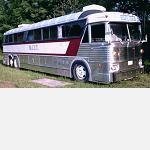 Rating: N/A |
Tim the bracket the can is bolted to is welded to the axle tube. I strongly recomend you hire a qualified weldor to do the work. Because if the weld were to break and you hurt some one because you had no brakes you could be a world of Poo if you can't prove a qualified person welded it on. The brake can bracket can be welded on the opposit side of the axle tube. I have done this at Manitoba Hwys Dept., when they were upgradeing the brakes on old truck plows. Dave L (Message edited by Dave_L on July 19, 2009) | ||
| Jim Wilke (Jim Bob) (Pd41044039)
Registered Member Username: Pd41044039 Post Number: 376 Registered: 2-2001 Posted From: 69.77.157.8 Rating: N/A |
George, when figuring the amount of braking force the driveline brake can apply, we should not forget that it has a mechanical advantage of somewhere between 3.22 to 4.11 to one because it works through the differential. | ||
| Len Silva (Lsilva)
Registered Member Username: Lsilva Post Number: 273 Registered: 12-2000 Posted From: 24.164.20.23  Rating: N/A |
I propose a "Bus Nuts Myth Busters", Fred's 4106 against a similar bus with spring brakes. We'll try emergency brakes at 20 mph to start, then go up from there. | ||
| George M. Todd (George_mc6)
Registered Member Username: George_mc6 Post Number: 912 Registered: 8-2006 Posted From: 76.171.79.185 Rating: N/A |
Jim, The driveline does indeed turn 3 to five times faster than the axles, but it doesn't help the small drum and shoes to dissipate heat one iota... While we're at it, why don't we try Fred's 4106 with a broken rear air hose against another bus with either DD3s or springs? Fred can flip his ICC switch, the other owner can pop his knob. Then Fred won't have to worry about selling his bus! I really wonder how he knows that "...the driveline brake on a sportscar is {ALMOST} the same as ONE rear brake"??? G | ||
| Tom Caffrey (Pvcces)
Registered Member Username: Pvcces Post Number: 1302 Registered: 5-2001 Posted From: 173.87.184.68 Rating: N/A |
I think that you've got him, there, George. Tom Caffrey PD4106-2576 Suncatcher Ketchikan, Alaska | ||
| Buswarrior (Buswarrior)
Registered Member Username: Buswarrior Post Number: 1655 Registered: 12-2000 Posted From: 76.69.143.82 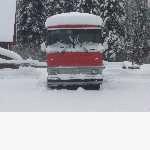 Rating: N/A |
A thread about making room for new brake chambers turns into this? FF encourages the OP to put some effort into reviving his OEM driveshaft brake, with the personal experience that it can stop the coach adequately. And then? There are times that threads on here become an embarrassment to contributing hobbyists. happy coaching! buswarrior | ||
| Buswarrior (Buswarrior)
Registered Member Username: Buswarrior Post Number: 1656 Registered: 12-2000 Posted From: 76.69.143.82  Rating: N/A |
Oops, forgot, Tim, how you making out? happy coaching! buswarrior | ||
| Tim Brandt (Timb)
Registered Member Username: Timb Post Number: 391 Registered: 10-2003 Posted From: 74.244.14.221  Rating: N/A |
Going to climb under this weekend | ||
| FAST FRED (Fast_fred)
Registered Member Username: Fast_fred Post Number: 889 Registered: 10-2006 Posted From: 76.195.234.106  Rating: N/A |
"I really wonder how he knows that "...the driveline brake on a sportscar is {ALMOST} the same as ONE rear brake"??? " I have both sizes of brake shoes,to compare. EZ, FF | ||
| Patrick levenson (Zubzub)
Registered Member Username: Zubzub Post Number: 101 Registered: 5-2007 Posted From: 70.51.33.246  Rating: N/A |
What the hell I'll put my 2 cents in. My driveshaft drum brake will stop my '04 pretty quick from 60 mph (like a moderatly fast foot brake/but my bus is light). It has to be set up well and if there is grease around you may need to check that there is no fire. I am in the middle of putting spring brakes on anyhow as I am concerned with a runaway situation on a steep decent. That being said I will keep the handbrake as it does not require the drums brakes to be functioning. I check my slack adjusters etc... but the thought of loosing brakes due to glazing or oil etc...makes me a kind of belts and suspenders kind of guy. FWIW when I was a teen I wore belts and suspenders and from bicycles on up I have always sorted my brakes before anything else. | ||
| Tim Brandt (Timb)
Registered Member Username: Timb Post Number: 392 Registered: 10-2003 Posted From: 66.165.176.62  Rating: N/A |
While I am under this weekend I will look into freeing up the driveline brake as well. Extra braking options in an emergency are probably not a bad thing | ||
| Kyle Brandt (Kyle4501)
Registered Member Username: Kyle4501 Post Number: 497 Registered: 9-2004 Posted From: 65.23.106.193 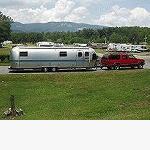 Rating: N/A |
I don't think you get anywhere close to 2/3 of a full service brake application from a spring brake. My spring brakes start to release at about 30 psi. (It takes 60 psi for the knob to stay in the off position. It also takes more than 30 psi to fully compress the spring due to the stroke & spring rate.) My air pressure fluctuates between 90 to 120 psi. The maximum pressure I can count on during normal use for a full service brake application is 90 psi (on all wheels). The spring brakes are only applying efectively 30 psi to 1 axle. So where do you get 2/3? I get closer to 1/6 for a 2 axle bus. BTW, my normal brake application pressure is usually well under 30 psi. Much over that & lots of stuff slides around in the bays & cabinets. Popping the knob to apply spring brakes results in a gentle stop. The spring brake is more than sufficient to prevent the vehicle from pulling off until it is released tho. . . . Back to the original post, if you're able to weld properly, rotating the brake can mount will be the path of least resistance. All you have to do is rotate it about the center of the S-cam shaft the slack adjuster mounts to. As for the strength/ quality of the weld needed, consider the forces involved. A #30 brake can can generate 3,600 pounds force at 120 psi, if you add in the ~30psi additional from the spring, you're at 4,500 pounds force if you have full air pressure to the brake cans with the spring brake applied. Shouldn't be a problem to be done properly. | ||
| George M. Todd (George_mc6)
Registered Member Username: George_mc6 Post Number: 914 Registered: 8-2006 Posted From: 76.171.79.185 Rating: N/A |
Kyle, I was talking about drum area, and diaphragm area. Its been pretty well agreed here that the driveshaft drum is about half the size of a front drum. So, if the driveshaft drum is a one, then the front drums must be twos, and the rears must be fours? Then 4 + 4 + 2 + 2=12, which makes the driveshaft brake equivalent to 1/12 of the service air brakes, in drum size, and in application force if we figure the lever and linkage gives the same amount of application force as a front can and S cams. As the emergencies only work on the drive axles of most buses, 8/12ths reduces to two thirds. The second number in a spring can (30/25, 30/30 etc.) is supposed to be the force applied by the spring, so probably a smaller second numbered can might start to release at 30 psi, but the mfr's must be right in their no pressure rating? In an apples to oranges comparison, popping the knob on my DD3s at ten mph results in more than a gentle stop. My whole point of getting involved in this thread was to explain the reason that ICC switches have been obsolete for 45 years... G | ||
| Kyle Brandt (Kyle4501)
Registered Member Username: Kyle4501 Post Number: 498 Registered: 9-2004 Posted From: 65.23.106.193  Rating: N/A |
G, your math & assumptions are flawed due to being overly simplistic, but that is only my opinion.  The basis for my opinion: Brakes work because they use simple friction to convert kinetic energy to latent energy (motion to heat). The friction coefficient = F/N F= force to move one object across another N= force pushing the objects together Surface area has nothing to do with torque capacity from simple friction. If you have deformation of the contact surfaces, you are no longer dealing with simple friction. (When your brakes go past simple friction, you are way behind on service & have bigger problems to deal with.) When it comes to drum brakes, output torque is determined by drum diameter, application force & brake friction. Typically, drum width relates to capacity (the more heat it can absorb & dissipate later) but not maximum torque. However, when you wrap a rim & tire around it, you severely restrict air flow which reduces heat capacity. A driveline brake typically won't have a rim & tire blocking air flow.  Drive line brakes have different criteria than axle wheel brakes due to the different operating conditions, so comparrisons are like apples to oranges. The larger heat dissapating capacity is needed for service brakes because they are used so often. A drive line brake is for a single stop. Quite a difference. There are lots of other things to consider too . . . ., like the friction coefficient changing as temperature rises. . . . . properly working system. . . . . proper maintenance. . . . Considering spring brake chambers, the second number is the size of the diaphram that compresses the spring to allow normal operation. For the spring to be fully retracted (compressed) at the standard of 60 psi, the pressure that just starts to retract the spring at full stroke out will be less. If I park on a slight incline, in neutral, when I hold the release button in as air pressure builds, my stuff will start to roll off when the air pressure hits ~30 psi. (Sure the brakes are lightly dragging, but they ain't holding.) DD3s & spring brakes may serve similar purposes, they work differently. For those who don't know, DD3s use a second diaphram to apply force & a system of wedges & etc to hold the rod in position when air pressure is released. I prefer the spring brakes because you don't need any air pressure to apply them, AND, the spring maintains pressure, not position. Think there is no difference in force vs position? Let the DD3 rod move a little if the locking wedge slips & see exactly what happens. As for the ICC brakes, I didn't see where anyone said that was all you needed. Looked to me others were saying If you lost main air, ICC was simply one of the choices -IF- you had a functioning mechanical brake. I like choices . . . . But, this is only my opinion . . . . (Message edited by kyle4501 on July 24, 2009) | ||
| George M. Todd (George_mc6)
Registered Member Username: George_mc6 Post Number: 915 Registered: 8-2006 Posted From: 76.171.79.185 Rating: N/A |
Kyle, I was indeed being simplistic, but I feel your reasoning is flawed much more than you accuse mine of being. 1. You mention a DD3 rod moving a little, and I assume a loss of braking force? How about the emergency brake lever and 30 some feet of linkage, plus the stuff to move the force from front to back to sideways? The engine and trans mounts are rubber, so what happens when braking effort torques the engine and trans and they move? 2. Regardless of how close the wheels are to the service drums, the driveshaft drum is approximately half the size of a front drum. Lets give it the same heat dissipating ability as one front drum twice its size, and the same force as a typical front can. The rear drums are twice as big, and the cans are considerably larger, exerting more force on the larger shoes. So, if we make the driveshaft brake equivalent to a front brake on a two-axle bus, then it would have 1/6 the swept area, force applied, and heat dissipating ability of the service brakes. As the rear cans are bigger, the actual fraction is less than a sixth. I simply question the ability of a driveshaft brake to stop a bus from speed on a grade! If you lose main air, ICC doesn't work at all. If you lose a rear hose or diaphragm, ICC doesn't work. If your rear transmission seal leaks, the handbrake won't work either, and you won't know it until its too late. I won't even mention a U-joint failure. G | ||
| Tim Brandt (Timb)
Registered Member Username: Timb Post Number: 394 Registered: 10-2003 Posted From: 74.244.14.221  Rating: N/A |
George, I don't know about all buses but on the flx the driveline brake is attached to a dedicated flange on the drop box opposite the driveshaft so Ujoint failure would have no affect. Have no fear I am working on upgrading to spring brakes but I am also going to try and get the driveline one working as a backup | ||
| Kyle Brandt (Kyle4501)
Registered Member Username: Kyle4501 Post Number: 499 Registered: 9-2004 Posted From: 65.4.179.12  Rating: N/A |
RE:I simply question the ability of a driveshaft brake to stop a bus from speed on a grade! Most aren't drivers who understand their equipment, but are instead merely steering wheel huggers that become spectators at the first bit of trouble. . . . True drivers operate their vehicles well within it's limits. No, I'm not a driver, yet. But I'm working towards that. There have been many reports of service brake failure due to excessive speed down grades. Is that due to faulty equipment or poor driver choices? If you have a vehicle with the driveline brake & it still has the stock HP, then adhering to the old adage "go down in the same gear you would go up" has a huge impact in the ability of the 'Oh Jesus' hand brake to stop the vehicle. If your service brakes fail going down a grade, you are already in a pile of trouble. Some failure modes render the axle brakes totally useless, so having that driveline break offers a little redundancy. But that redundancy shouldn’t be enough that one becomes complacent with maintenance. I never said spring brakes = drive line brakes. I did say there were different criteria that apply to drive line vs service brakes. Those criteria include heat disapation, speed, forces, size, frequency of use, etc That is why it is foolish to try to equate driveline brakes to service brakes based on casual observations concerning size. BTW, don't underestimate the effect of speed on kinetic energy. . . . . Also, difficult service is no excuse for poor maintenance! It may be a good reason to improve/ upgrade certain components. If Ignorance is bliss, why aren't I more blissfull? What is that other adage? Ignorance is no excuse. . . Good discussion here, hope it helps some understand the diferences. . . |